
Incredible night sky events coming up this summer
Warm summer nights are excellent for stargazing and skywatching.
In Summer 2020, the first big astronomical event takes place on the night of June 21, for those of us in the western hemisphere. We, here in Canada, will not be able to see it simply by looking up into the sky, though.
On that night, on the other side of the planet, viewers from eastern Africa, Saudi Arabia, Pakistan, northern India and central China will be watching an Annular Solar Eclipse.
Solar eclipses occur when the Sun, New Moon and Earth line up perfectly, so that the Moon blocks out some or all of the light from the Sun. When the angle is just right, and the Moon completely covers the Sun, it's known as a Total Solar Eclipse. If this occurs when the Moon is farther away from Earth, during its apogee, it will only cover most of the Sun, leaving a bright 'ring' around it. This is known as an Annular Solar Eclipse, or a "Ring of Fire" eclipse.
Visit our Complete Guide to Summer 2020 for an in-depth look at the Summer Forecast, tips to plan for it and much more
This is the second annular eclipse that has passed over this part of the world in just over six months, and it follows a very similar path. The shadow cast by the Moon will fall on eastern Africa first, and then it will slowly crawls across eight different time zones over the course of just under four hours, before the event ends around sunset in the western Pacific Ocean.
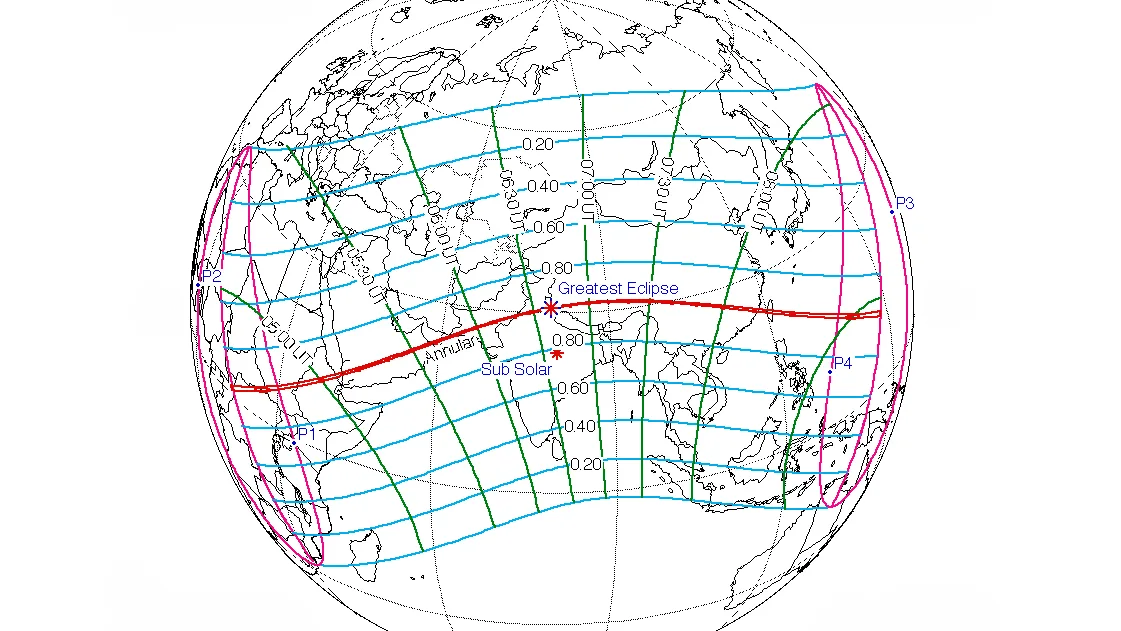
The path of the annular solar eclipse on June 21, 2020. Credit: NASA/Fred Espenak
Along the path of totality - the narrow strip of Earth's surface where the full eclipse will be visible - viewers have a chance to see the Sun as a blazing 'ring of fire' in the sky for just 38 seconds!
For viewers in Canada, the maximum eclipse occurs at 2:39 a.m. EDT on June 21. So, although we'll have to stay up late to watch it, we will not miss out on the show.
SUMMER ASTRONOMY
June 21 - Annular Solar Eclipse across Asia
July through September - Comet C/2020 F3 (NEOWISE)
July 4-5 - Lunar Eclipse near Jupiter & Saturn
July 10 - Venus greatest illumination extent
July 11-12 - Moon near Mars
July 14 - Jupiter closest to Earth (Opposition)
July 20 - Saturn closest to Earth (Opposition)
Aug 1-2 - Moon passes by Jupiter & Saturn
Aug 9-10 - Moon close to Mars
Aug 12 - Perseid peak (last quarter moon)
Aug 15 - Venus + crescent moon
Aug 21 - Seasonal Black Moon
Aug 29-30 - Moon passes by Jupiter & Saturn
Sept 6-7 - Moon very close to Mars
Sep 14 - Venus + crescent moon
Sep 15 - Zodiacal Light in E before AM twilight for 2 weeks
A BRIGHT COMET SWINGS BY
Starting in early July, a special visitor to the inner solar system became visible in the early morning sky, and it should remain visible for much of the season.
Comet C/2020 F3 (NEOWISE) was first discovered on March 27, 2020, as it approached the Sun from below the ecliptic plane. It was found to be on a very long journey, originating in the Oort Cloud, and its orbit would have it swinging up past the Sun, just beyond the orbit of Mercury, and then above the inner planets on its way back to the outer reaches of the solar system.
Now having survived its trip around the Sun, the comet is putting on a show in the predawn sky.
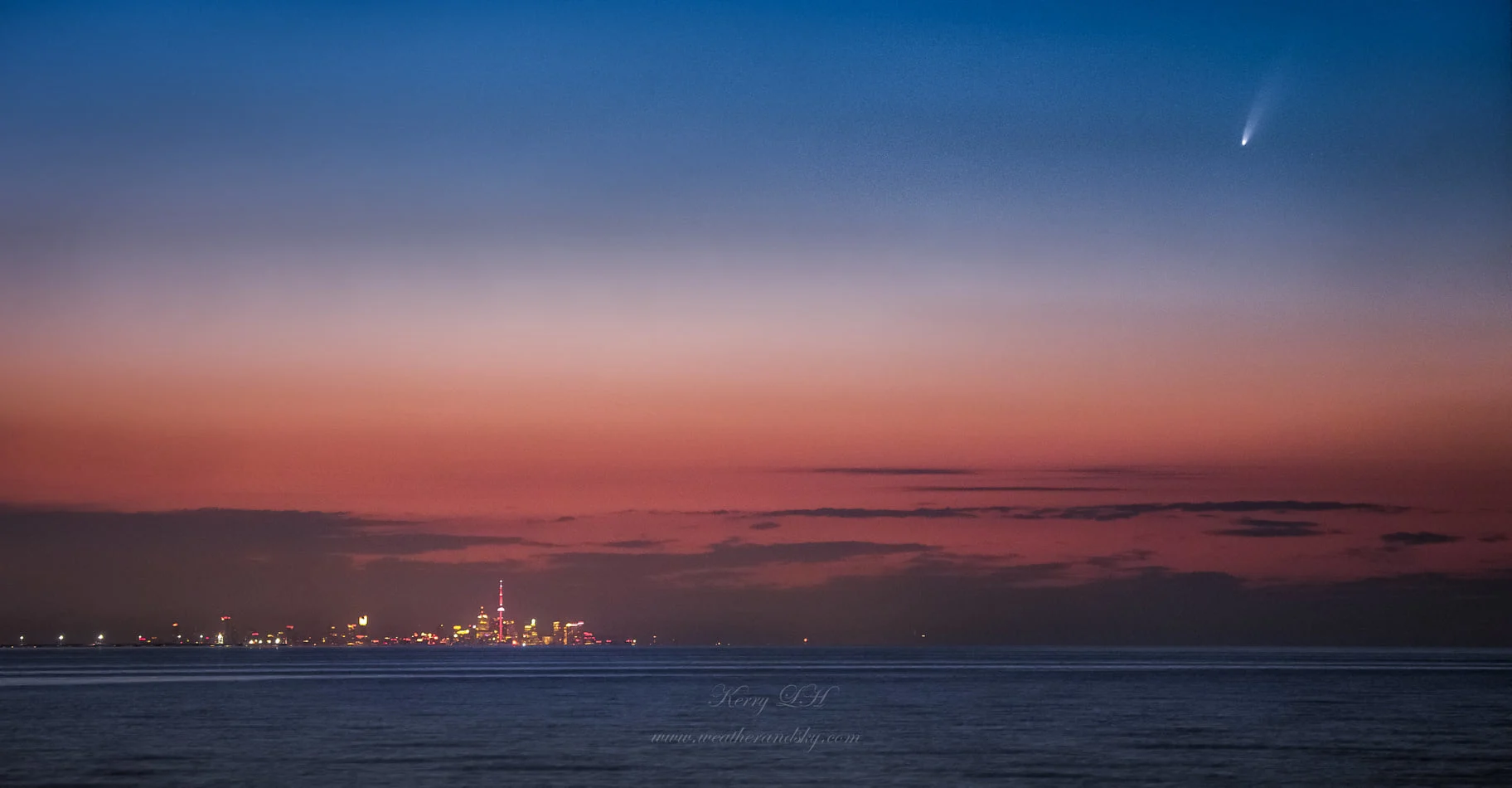
This long-exposure image of Comet C/2020 F3 (NEOWISE) was captured on the morning of July 5, 2020 by Weather Network meteorologist and astrophotographer Kerry-Ann Lecky Hepburn
The above image is an idealized view, of course. It is comprised of several 1-minute image exposures, stacked on top of one another via imaging software, to bring out the most details from the comet and its tail. According to Weather Network meteorologist Kerry-Ann Lecky Hepburn, who took the photo, the comet was only visible to the unaided eye by what is known as "averted vision". This is where you do not look directly at the object, but instead look just off to the side, to use your peripheral vision.
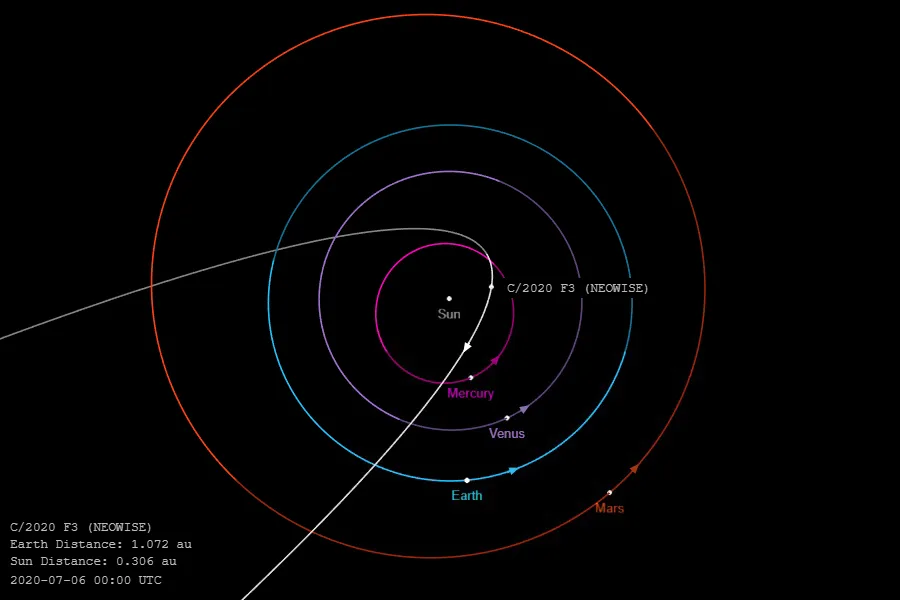
A computer model of the inner solar system shows the path of Comet C/2020 F3 (NEOWISE). Credit: NASA JPL
In the days ahead, this comet will switch from being a pre-dawn object to a post-sunset one, as it crosses 'between' Earth and the Sun. Then, for the rest of July, August and into September, it will be visible in the evening sky. The comet is best viewed with binoculars or a telescope, and from an area as far away from city light pollution as possible.
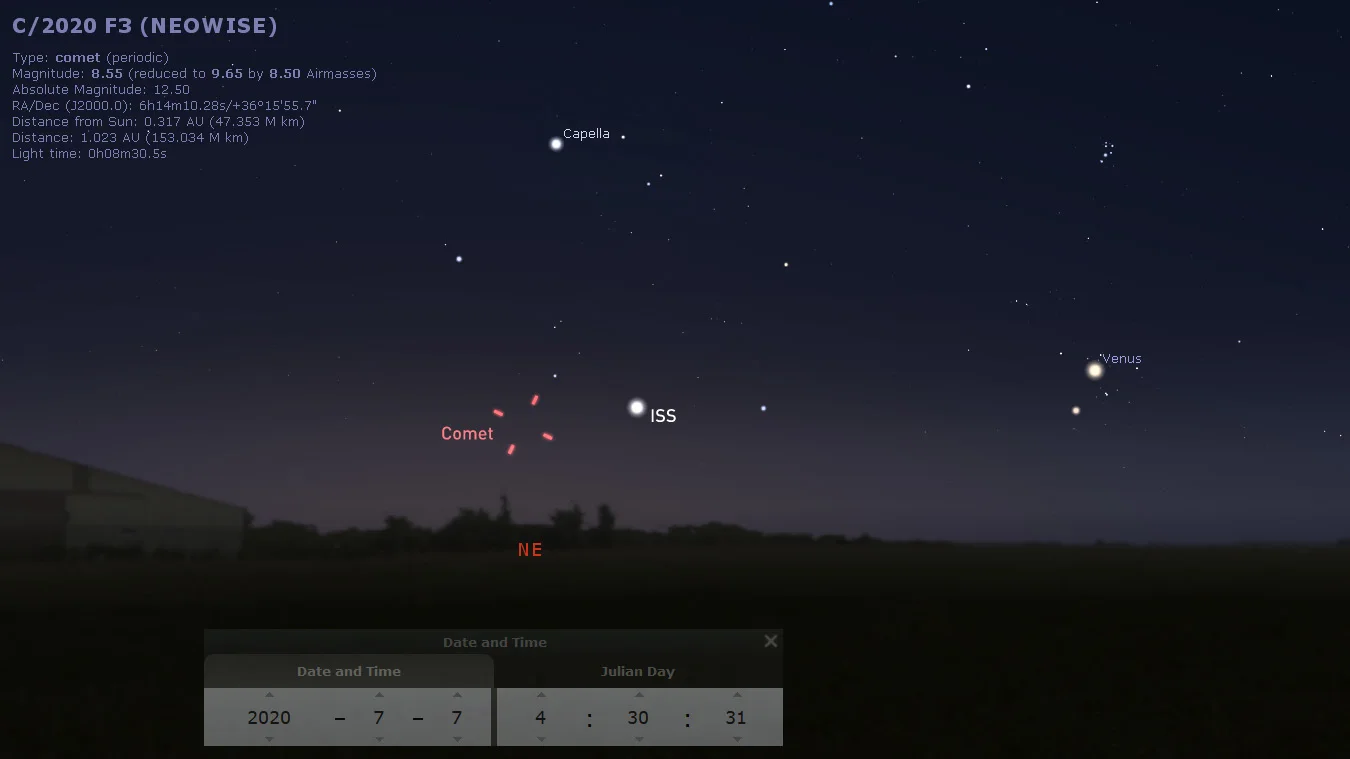
C/2020 F3 (NEOWISE) is visible in the northeast, currently, between 3:30 a.m. and 4:30 a.m., local time. This image shows its location on the morning of July 7, 2020, at 4:30 a.m. ET, from southern Ontario. A pass of the International Space Station is also noted. Credit: Stellarium
THE MOON AND THE PLANETS (PLUS AN ECLIPSE!)
Three times during Summer 2020, the Moon will pass very close to the planets Jupiter and Saturn in the night sky.
The first of these events is a bit more special, provided you look at the Moon very closely on that night. This will require a good pair of binoculars or a telescope, a sharp eye, and a little bit of patience.
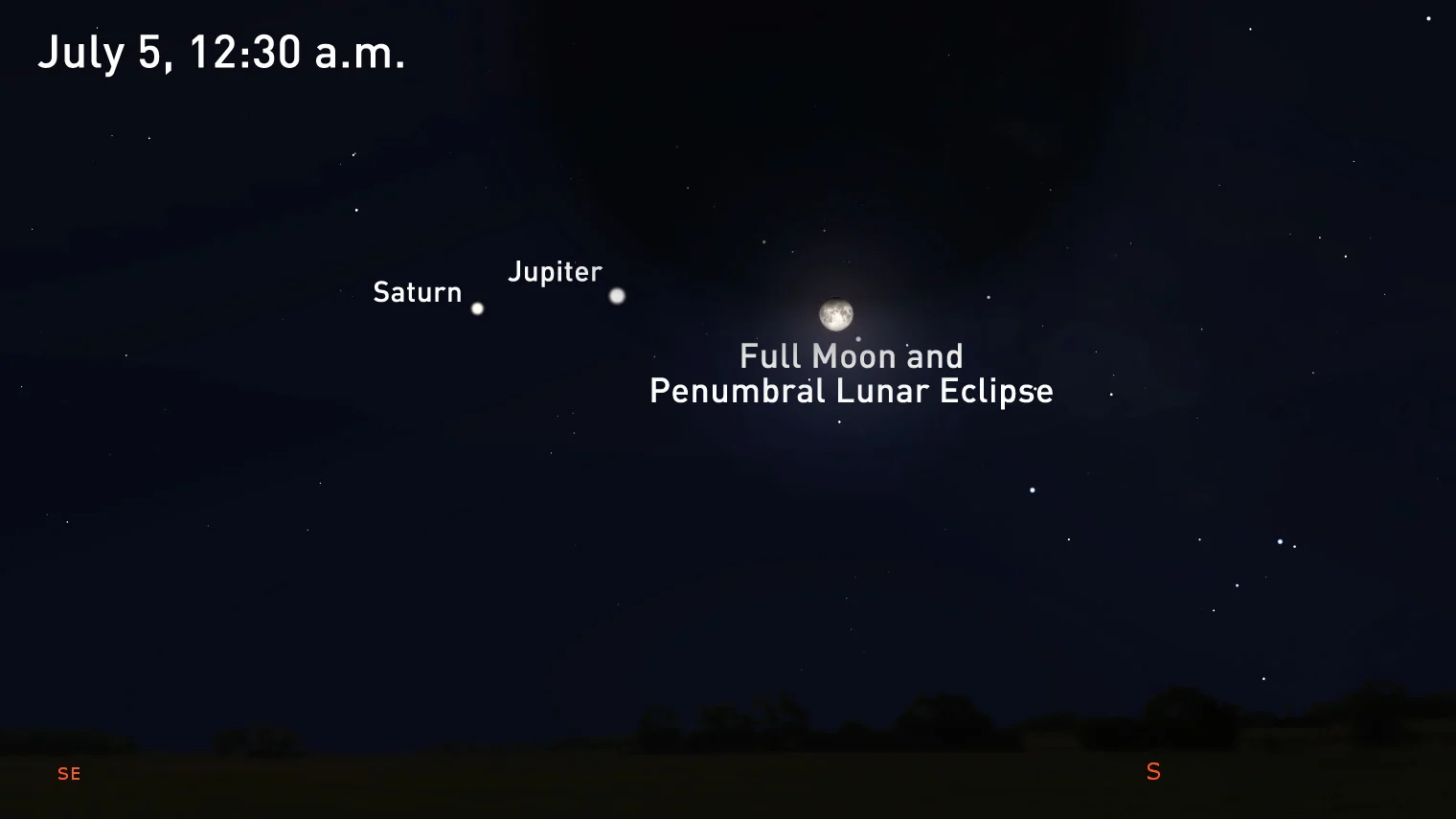
The Full Moon, Jupiter and Saturn, in the southern sky on the night of July 4-5, 2020. Credit: Stellarium
On the night of July 4-5, as the Full Moon hangs near the two largest planets in our solar system in the sky, it will clip the lower portion of Earth's shadow, producing a Penumbral Lunar Eclipse.
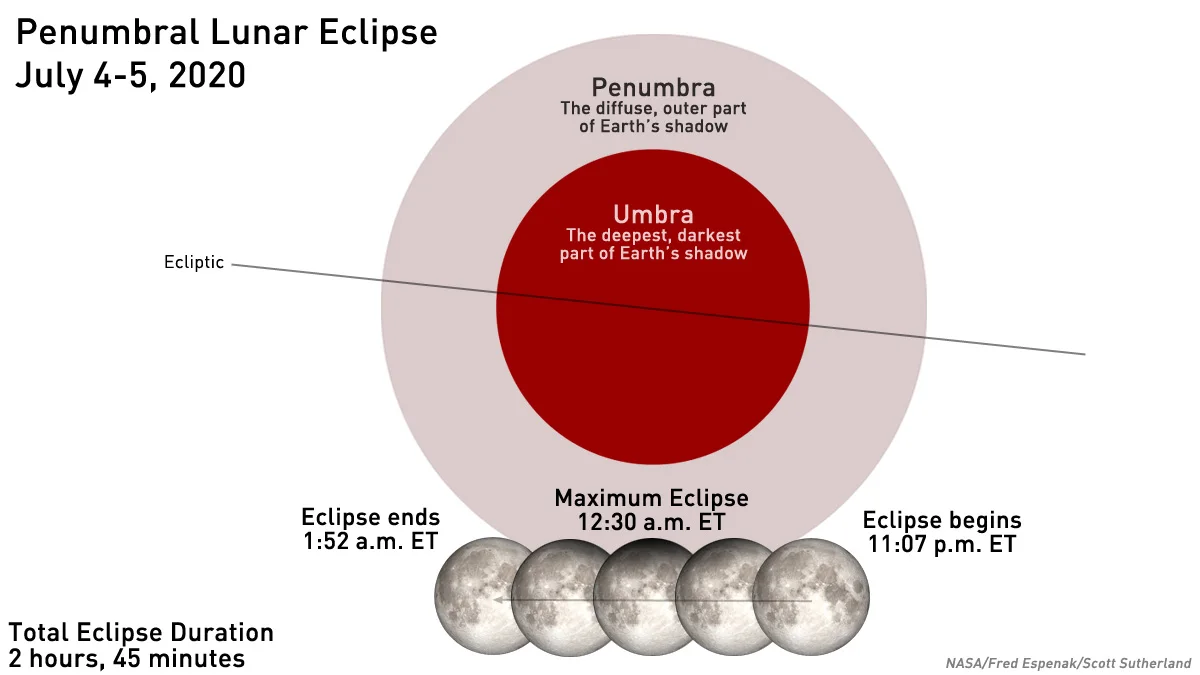
Without some kind of help from a telescope or binoculars, it isn't easy to see a penumbral lunar eclipse. During a partial or total lunar eclipse, at least part of the Moon passes through the deep red inner part of Earth's shadow (the umbra). So, it is easy to see the changes to the colour of the lunar surface during the event. During a penumbral lunar eclipse, the Moon passes through the diffuse outer part of Earth's shadow (the penumbra). This doesn't cause a dramatic colour change, but instead just causes the Moon to dim slightly.
The Moon will swing past Jupiter and Saturn on the nights of August 1-3 and August 29-30, but we'll have to wait until the night of November 30 for the next penumbral lunar eclipse.
In addition to the Moon paying Jupiter and Saturn a visit each month, it will also swing past two other planets. Look up in the hours after midnight on July 11-12 and July 12-13 to see the Moon near Mars. The two get even closer in the hours after midnight on August 9-10, and the two actually appear to touch in the sky around midnight on September 6-7. In the predawn hours of August 15 and September 14, look to the east to see the Crescent Moon near Venus.
GIANT OPPOSITIONS
The two largest planets in the solar system, Jupiter and Saturn, will be reaching Opposition within days of one another this year.
'Opposition' is an astronomical term for the exact moment when Earth is directly between the Sun and another planet, such as Mars, Jupiter or Saturn.
On July 14, Earth will be lined up perfectly between the Sun and Jupiter.
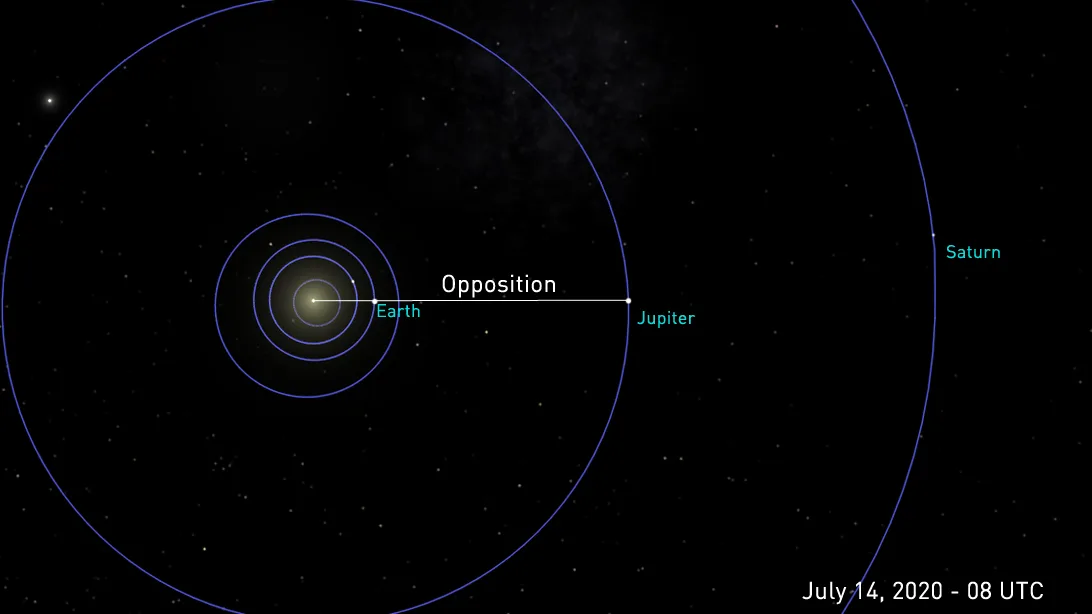
The Sun, Earth and Jupiter line up perfectly in Opposition on July 14, 2020. Credit: Celestia/Scott Sutherland
By six days later, on July 20, Earth will have moved out of alignment with Jupiter, and will instead line up between the Sun and Saturn.

The Sun, Earth and Saturn line up perfectly in Opposition on July 20, 2020. Credit: Celestia/Scott Sutherland
This is just a preview of what's to come for this two gas giants, however. Later this year, on December 21, both Jupiter and Saturn will line up together on the oposite side of the Sun from Earth, in an alignment known as Grand Conjunction.
THE PERSEID METEOR SHOWER
By far the best of the summer meteor showers, and one of the best of the entire year, the Perseid Meteor Shower runs between July 17 and August 24, and reached its peak on August 12.
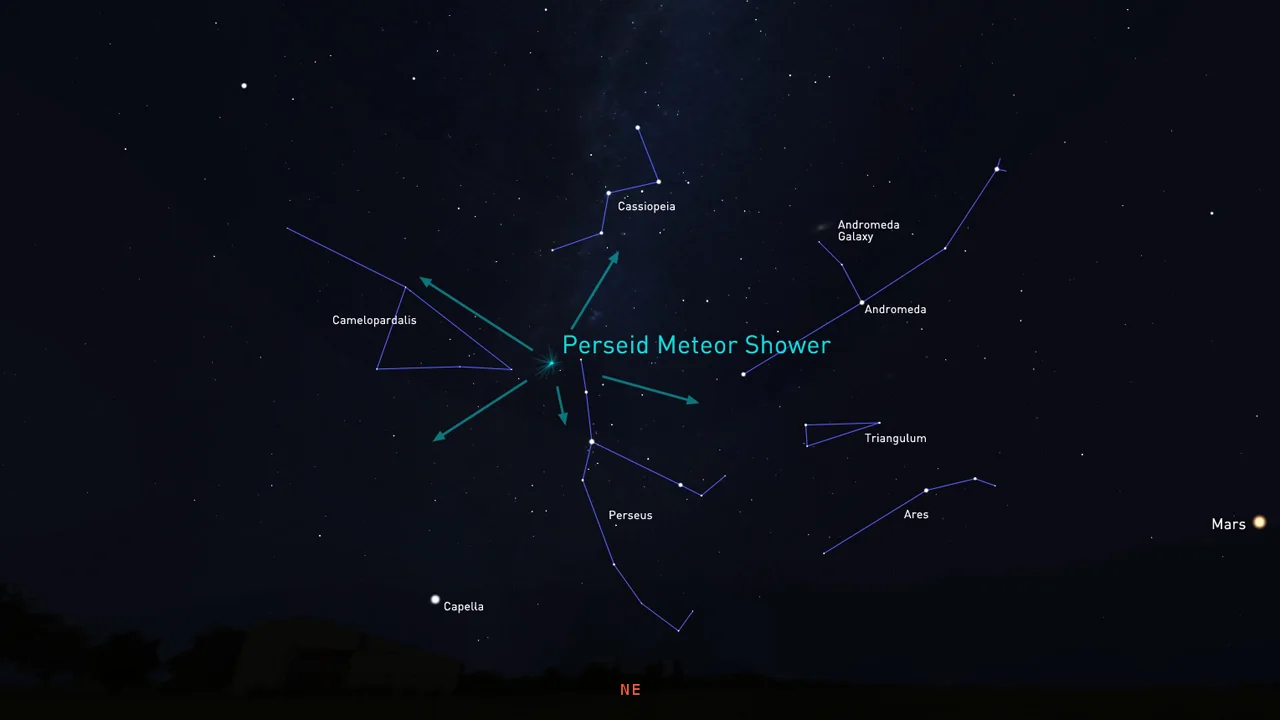
The location of the Perseids radiant at midnight on August 12-13. Credit: Stellarium/Scott Sutherland
NOTE: Scroll down to the bottom of the article for a handy guide on how to get the most out of watching a meteor shower!
During its peak, the Perseids can deliver over 100 meteors per hour under ideal conditions. This ramps down to maybe 60 per hour the night after, 50 per hour the night after that, and so on over the period of about a week. The typical viewer, after they've gotten away from city light pollution, tends to see about half that number or perhaps one every minute or so.
The radiant of the Perseids - the position in the sky that the meteors appear to originate from - never sets below the horizon at this time of year. So, it's only a matter of waiting for the Sun to completely set in order to watch.
Since this year's shower is expected to reach peak at between 13-16 UTC on August 12, the best times to watch will probably be in the hours before dawn, and then again between sunset and midnight on the 12th. Since the third-quarter Moon will be up in the sky during the morning viewing window, expect its light to wash out some of the dimmer meteors.
The Perseids also has the distinction of being the one annual shower with the greatest number of fireballs - very bright meteors that are as bright as, or brighter than, the planet Venus.
Watch: Perseid fireball captured on camera
BLACK MOON!
We've all heard of a Blue Moon, but have you heard of its opposite - the Black Moon?
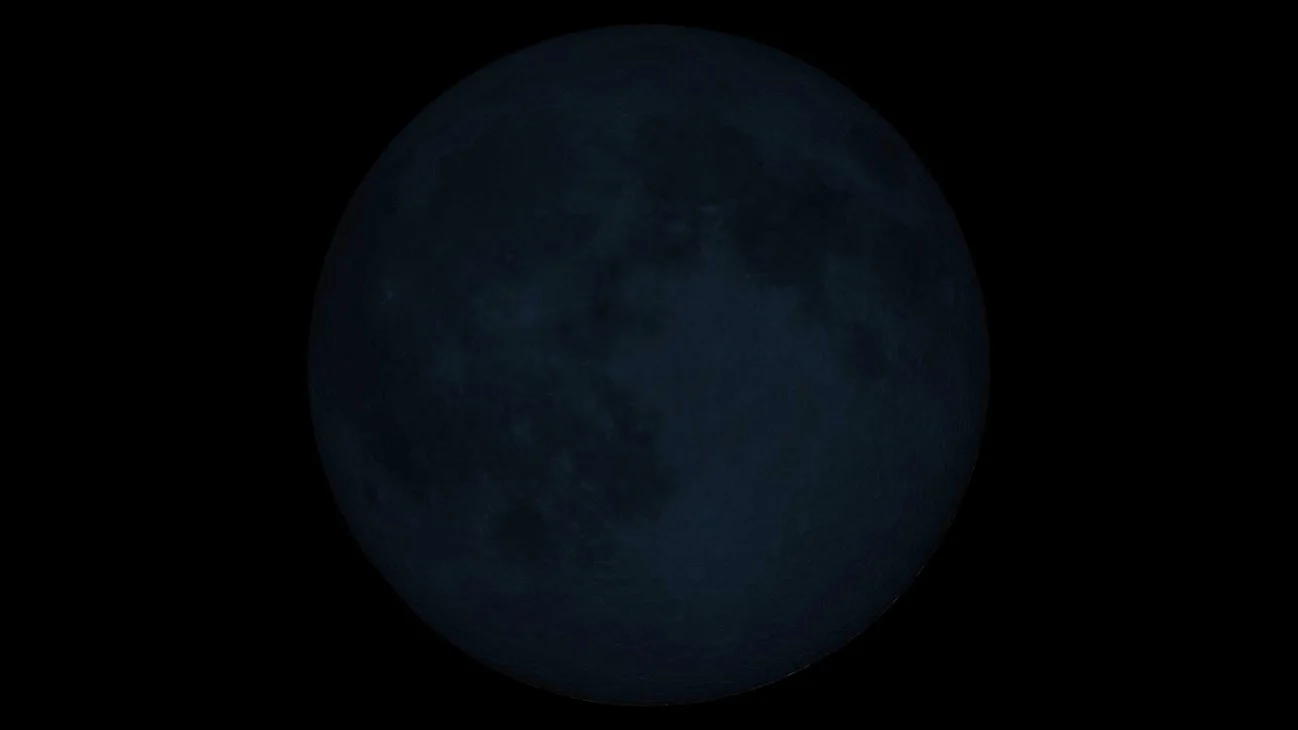
The August 19 Black Moon. Credit: NASA Goddard Scientific Visualization Studio
The traditional definition of a Blue Moon is "the third Full Moon in a season with four Full Moons".
Normally, we see three Full Moons in a three-month season. When a Full Moon occurs within a day or two of a season's start, though, that season will end up with a total of four Full Moons. The third of those is a Blue Moon. This applies to New Moons as well. When we end up with four New Moons in a season, the third one is called the Black Moon.
While there are only three Full Moons in Summer 2020 - on July 5, August 3 and September 2 - there are four New Moons, on June 21, July 20, August 19 and September 17. Thus, the August 19 New Moon is the Black Moon of 2020.
One catch to this: noone is going to see it.
A New Moon happens when the Moon lines up between the Earth and the Sun. So, it becomes lost in the glare of the Sun's light. The only time you can ever see a New Moon, without the help of some serious astronomical equipment, is during a solar eclipse.
THE ZODIACAL LIGHT
In late summer, sharp-eyed skywatchers will have a chance to spot an elusive phenomenon known as "The Zodiacal Light".
On clear nights, and under dark skies, look to the eastern horizon, in the half an hour just before morning twilight begins, from September 15-29. Look for a pyramid-shaped white glow, with the base along the horizon and the point angled towards the south.
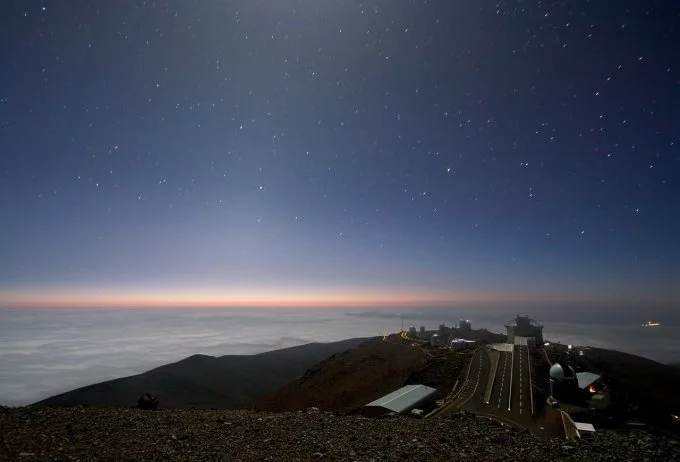
Moonlight and zodiacal light over La Silla. Credit: ESO
In the Royal Astronomical Society of Canada's 2020 Observer's Handbook, Dr. Roy Bishop, Emeritus Professor of Physics from Acadia University, wrote: "The zodiacal light appears as a huge, softly radiant pyramid of white light with its base near the horizon, and its axis centred on the zodiac (or better, the ecliptic). In its brightest parts, it exceeds the luminance of the central Milky Way."
The zodiacal light is caused by sunlight refracting off tiny bits of dust and ice that orbit around the Sun in the plane of the ecliptic (the same plane the planets orbit in). It is thought that this cloud originates from dust and ice blown off of comets.
According to Dr. Bishop, even though this phenomenon can be quite bright, the light is so diffuse that it can easily be spoiled by moonlight, haze or light pollution. Also, since it is best viewed just before morning twilight or just after evening twilight, inexperienced viewers sometimes confused it for twilight and thus miss out.
TIPS FOR STARGAZING & METEOR WATCHING
First, some honest truth: Many people who want to watch a meteor shower end up missing out on the experience, unnecessarily.
Since the Moon and most planets are so bright in the night sky, it's easy to fall into the expectation that watching a meteor shower will be just as easy. It takes a bit of travel and effort to get the most out of a meteor shower, but it is well worth it!
First off, there's no need to have a telescope or binoculars to watch a meteor shower. They'll actually make it harder to see the event, because they restrict your field of view.
Here's the three 'best practices' for watching meteor showers:
Check the weather,
Get away from light pollution, and
Be patient.
Having clear skies is very important for meteor-spotting. Even a few hours of cloudy skies can ruin an attempt to see a meteor shower. So, be sure to check The Weather Network on TV, on our website, or from our app, and look for my articles on our Space News page, just to be sure that you have the most up-to-date sky forecast.
Next, you need to get away from city light pollution. If you look up into the sky are the only bright lights you see street lights or signs, the Moon, maybe a planet or two, and passing airliners? If so, your sky is just not dark enough for you to see any meteors. It's possible you might catch a bright fireball, but there's no guarantee, and those are typically few and far in-between. So, get out of the city, and the farther away you can get, the better!
Watch: What light pollution is doing to city views of the Milky Way
For most regions of Canada, getting out from under light pollution is simply a matter of driving outside of your city, town or village. Once you're out from under the dome of city lights, a multitude of stars becomes visible above your head. In some areas, however, such as in southwestern and central Ontario, and along the St. Lawrence River, the concentration of light pollution is too high. Getting far enough outside of one city to escape its light pollution, unfortunately, tends to put you under the light pollution dome of the next city over.
In these areas of concentrated light pollution, there are dark sky preserves, however, a skywatcher's best bet for dark skies is usually to drive north and seek out the various Ontario provincial parks or Quebec provincial parks. Even if you're confined to the parking lot, after hours, these are usually excellent locations from which to watch (and you don't run the risk of trespassing on someone's property).
Sometimes, based on the timing, the Moon is also a source of light pollution, and it can wash out all but the brightest meteors. We can't get away from the Moon, so in these situations, we can just make do, as best we can.
Once you've verified you have clear skies, and you've gotten away from light pollution, this is where having patience comes in.
For best viewing, it is crucial that you give your eyes time to adapt to the dark. Give yourself at least 20 minutes, but the longer, the better. Just as a warning, if you skip this step, even if you follow the rest of the steps, above, you are going to miss out on a lot of the action.
During this adjustment time, avoid all bright sources of light - overhead lights, car headlights and interior lights, and cellphone and tablet screens. Any exposure to bright light during this period will cancel out some or all the progress you've made, forcing you to start over. Shield your eyes from light sources, and if you need to use your cellphone during this time, set the display to reduce the amount of blue light it gives off, and reduce the screen's brightness as much as possible. Also, it may be worth finding an app that puts your phone into 'night mode', which will shift the screen colours into the red end of the light spectrum, which has less of an impact on your night vision.
You can certainly look up into the starry sky while you are letting your eyes adjust. You may even see a few brighter meteors as your eyes become accustomed to the dark. If the Moon is shining brightly in the sky, turn so that it is out of your personal field of view.
Once you're all set, just look straight up!
Sources: IMO | RASC | TimeandDate.com | With files from The Weather Network. Thumbnail courtesy of Justin Dickey/Unsplash.
